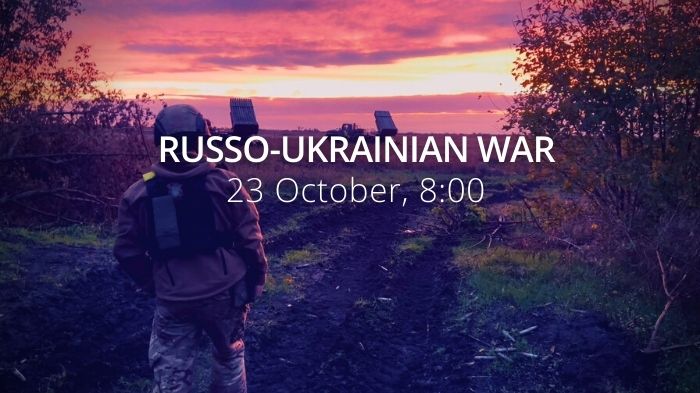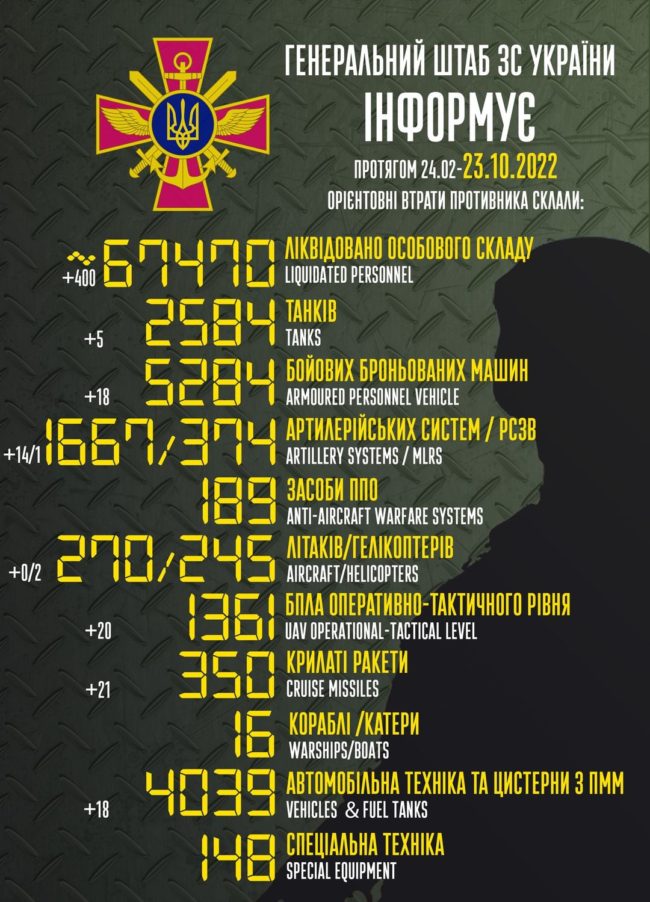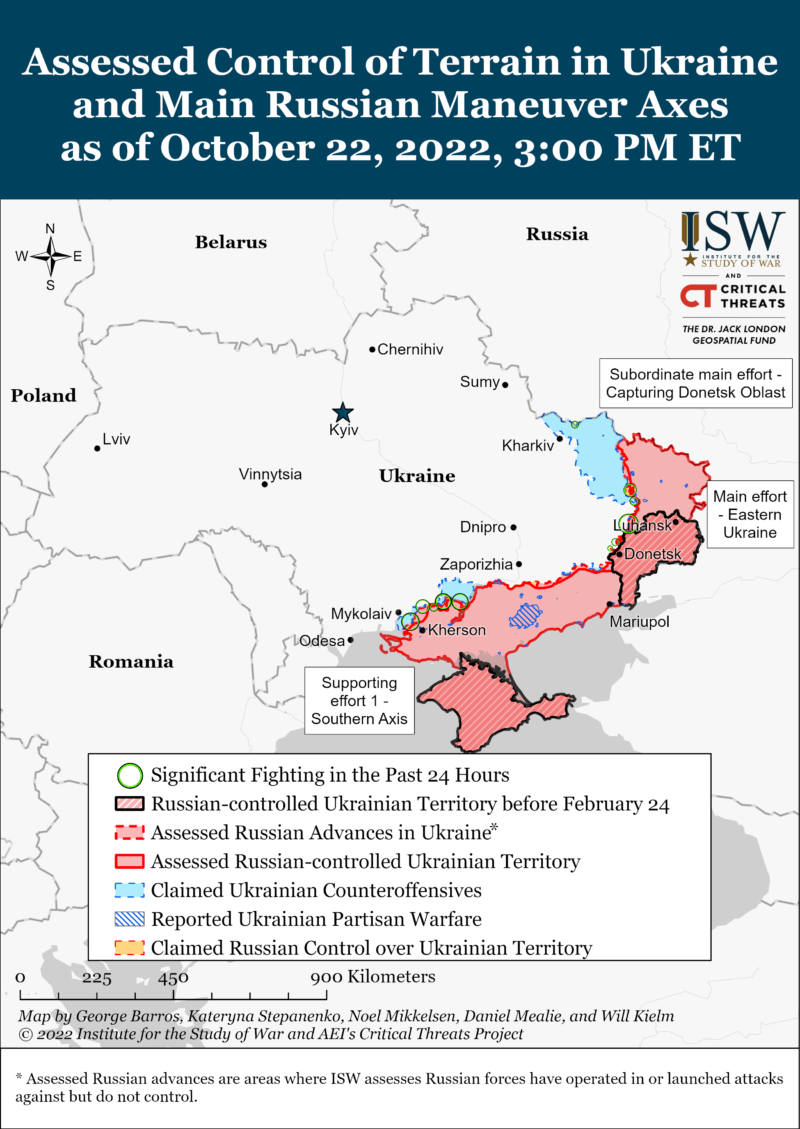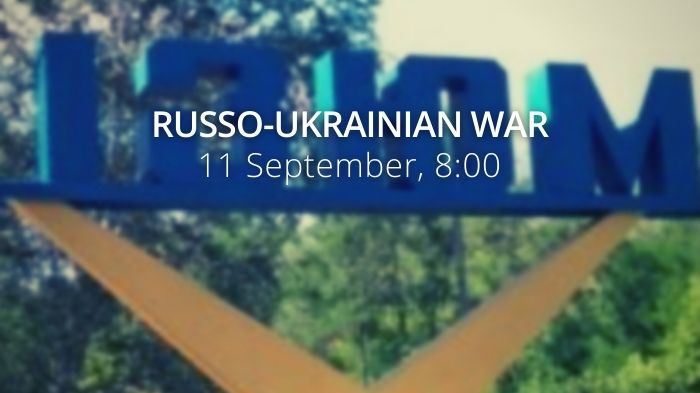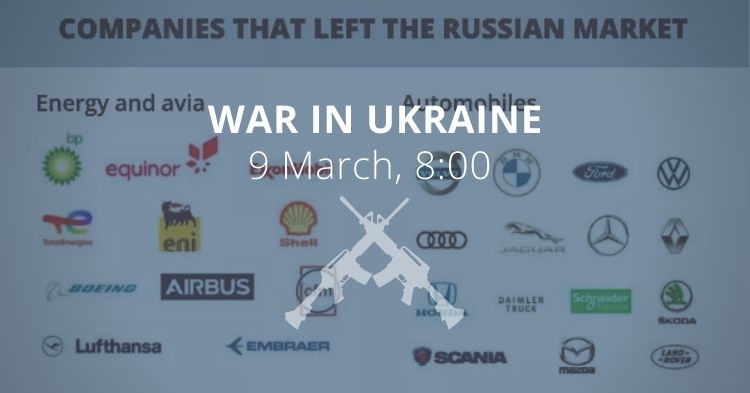Russia continued to withdraw from Kherson Oblast’s west while preparing to conduct delaying actions that will likely be only partially effective. Ukrainian parliament introduced a draft resolution recognizing Belarus temporarily occupied country. Russian forces continued large-scale strikes on Ukrainian infrastructure leaving 1.5 million Ukrainians without electricity. Ukrainian FM calls for Russia to be stripped of its seat in UN Security Council due to war crimes in Ukraine.
Daily overview — Summary report, October 24
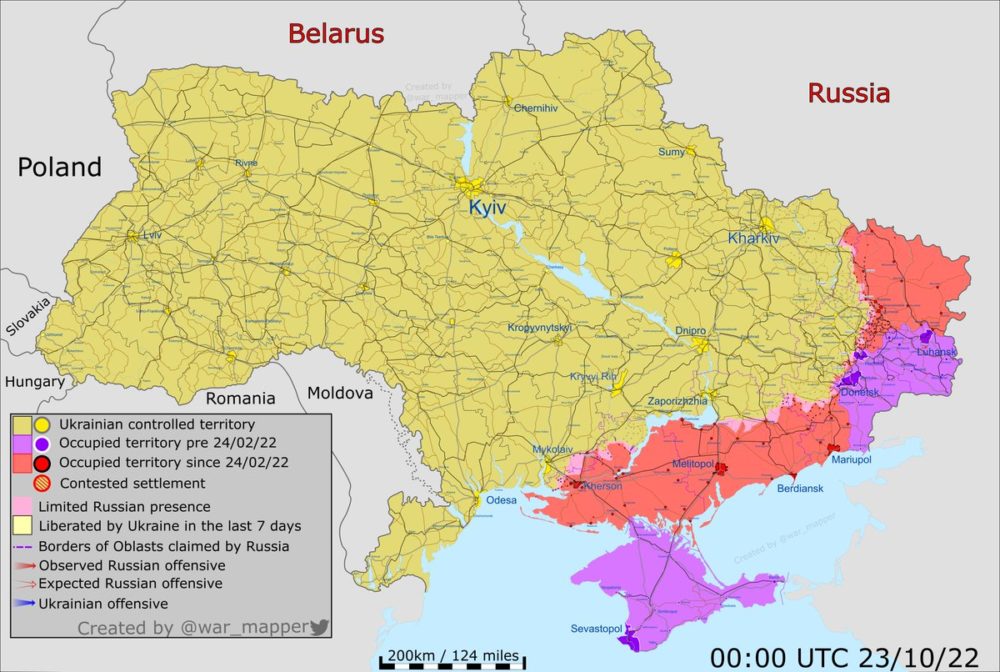
The General Staff’s operational update regarding the Russian invasion as of 06.00 am, October 23, 2022 is in the dropdown menu below:
“Russian forces are trying to hold the temporarily captured territories, concentrating efforts on restraining the actions of the Defence Forces in certain directions, at the same time, it does not stop trying to conduct offensive actions in the Bakhmut and Avdiivka directions.
Over the past 24 hours, units of the Defense Forces repelled the attacks of the occupiers in the areas of the settlements of Bakhmut, Bakhmutske, Ivanhrad, Mariinka, Soledar, Ozaryanivka, Odradivka in the Donetsk oblast and Bilohorivka in the Luhansk oblast.
Russian forces are shelling the positions of our troops along the contact line and conducting aerial reconnaissance. Last day, the Russian occupiers again resorted to massive shelling of critical infrastructure and civilian housing, violating the norms of International Humanitarian Law, laws and customs of war. More than half of the cruise missiles and attack UAVs were shot down by the Defence Forces of Ukraine. [Our defenders managed to shoot down 20 cruise missiles and 11 UAVs.]
Russia starts using Kh-101 missiles produced in Q2 of 2022 – Defense Express
In total, over the past day, the invaders launched 32 missile strikes, 25 airstrikes and more than 80 MLRS attacks. Energy and critical infrastructure facilities in the Volyn, Rivne, Kharkiv, Khmelnytskyi, Kirovohrad, Cherkasy, Zaporizhzhia, Odesa, and Mykolaiv regions were hit by enemy attacks.
The situation in the Volyn and Polissya directions has not changed significantly.
Russian forces shelled in such directions:
- in the Siversky direction – from mortars and artillery, in the areas of the settlements of Hudove and Khodyne of the Chernihiv oblast and Seredyna Buda, Vovkivka and Yunakivka of the Sumy oblast;
- in the Kupiansk and Lyman directions – from mortars, artillery and MLRS, in the areas of the settlements of Kolodyazne, Kotlyarivka, Kyslivka of the Kharkiv oblast, Stelmakhivka of the Luhansk oblast, and Zarichne and Terny in the Donetsk oblast;
- in the Bakhmut direction – from tanks and artillery of various calibres, in the areas of Andriivka, Bakhmutske, Bakhmut, Vesele, Zelenopilya, Klishchiivka, Mayorsk, Kurdyumivka, Ozaryanivka, Opytne, Soledar and Yakovlivka settlements of the Donetsk oblast;
- in the Avdiivka and Zaporizhzhia directions – from tanks, mortars, artillery and MLRS, in the areas of the settlements of Avdiivka, Vremivka, Velyka Novosilka, Vuhledar, Novobakhmutivka, Neskuchne in Donetsk region, and Dorozhnyanka and Orihiv in the Zaporizhzhia region.
- In the Pivdennyy Buh direction, Russian forces shelled the military and civilian infrastructure of more than 20 settlements near the contact line. Among them are Bezymenne, Bilohirka, Davidiv Brid, Novogryhorivka, Novoukrainka, Partyzanske, Pravdyne and Chervona Dolyna.
According to detailed information, the destruction of enemy personnel and equipment in the previous days has been confirmed:
- in Nova Kakhovka, Kherson oblast, as a result of the damage to the location of the invaders, 6 units of weapons and military equipment were destroyed and up to 150 servicemen were injured;
- in the Zaporizhzhia region, 5 units of weapons and military equipment were destroyed and about 100 servicemen were injured. Information about the dead occupiers is being clarified.
- [According to detailed information, as a result of the strikes of the Defence Forces during the last few days, it was confirmed that Russian manpower and equipment were damaged in the Zaporizhzhia oblast. About 200 servicemen were killed, and more than 150 were wounded. An ammunition warehouse and 10 units of weapons and military equipment were also destroyed.]
Russia hits Zaporizhzhia with drones and S-300 missiles, injures six in Nikopol
[Separate units of the Russian occupation forces continue to leave the temporarily occupied territory of the Kherson oblast. At the same time, cases of looting and robbery of local residents have become more frequent. According to available information, Russian forces have completely left the settlements of Charivne and Chkalove, and officers and medical personnel have been evacuated from Beryslav.]
Russian troops withdraw from two villages in Kherson Oblast – Ukraine’s GenStaff
[The number of cases of looting and illegal actions in the city of Kherson has increased. The occupiers seize cars from the local population and try to leave the city with the help of a ferry crossing in the area of the Antonivsky Bridge.]
[The practice of placing enemy units in the premises of educational institutions in the temporarily occupied territory of the Zaporizhzhia region continues. At the same time, the educational process of children of local residents continues.]
Aviation of the Defense Forces carried out 17 strikes during the past day. It has been confirmed that 15 areas of concentration of weapons and military equipment, as well as two positions of Russian anti-aircraft missile systems, have been destroyed. Air defence units shot down one Ka-52 helicopter and 3 Orlan unmanned aerial vehicles.
Over the past 24 hours, military personnel of the missile forces and artillery hit three control points, six areas of concentration of manpower, weapons and military equipment, an ammunition depot and five other important enemy facilities, including one radar station.“
Military Updates
Russian troops launched 40 missile strikes on Ukraine on Oct 22 – General Staff, Ukrinform reports. “Russian forces launched 40 cruise missiles and 16 Shahed-136 attack drones on targets in Ukraine on October 22, with Ukrainian defenders shooting down 20 missiles and 11 Shahed-136s.
According to the report, Russian forces attacked energy and critical infrastructure in nine regions, in particular, the Volyn, Rivne, Kharkiv, Khmelnytskyi, Kirovohrad, Cherkasy, Zaporizhzhia, Odesa and Mykolaiv regions.”
[The Air Force of Ukraine reported that on the morning of 22 October that Russia attacked Ukraine using X-101 and Kalibr cruise missiles; 18 of these were shot down by air defence systems.”]
Six Russian vessels near Crimea, 16 Kalibr cruise missiles on standby, Ukrainska Pravda reports, citing Operational Command Pivden (South). “Six Russian vessels are manoeuvering along the coastline of temporarily occupied Crimea in the stormy Black Sea. It is understood that two large landing ships and two missile carriers armed with 16 Kalibr cruise missiles are currently on standby.
Operational Command has warned that, even though the number of missile carriers has decreased, this is no time to lose vigilance as missile launches and large-scale kamikaze drone attacks, including those on critical infrastructure, are quite possible.”
Fire breaks out at Perm plant where charges for Grad and Smerch MLRS are made, Ukrainska Pravda reports, citing TASS, The Insider, and 112. “A fire has broken out at the [Russian] Perm Powder Plant where charges for Grad and Smerch multiple-launch rocket systems and air defence systems are produced, killing two people and injuring another.”
The Insider points out that since the beginning of the war in Ukraine, fires have been occurring at the facilities of the Military-Industrial Complex (MIC) of the Russian Ministry of Defense. The cause of the fires is called a violation of fire safety rules, in some cases, even preliminary versions are not disclosed.
“The last time there was a fire at the Perm gunpowder factory was reported was on May 1, when there were also two dead. At production site No. 12 of Plastmassy, products were allegedly on fire. Before the fire, local residents heard an explosion, Ekho Perm reported. Before that, a fire broke out at another enterprise of the Ministry of Defense: on April 21, at the Central Research Institute of the Aerospace Defense Forces in Tver, about 30 people were injured as a result of a fire, and 17 died. The cause of the fire was called the emergency state of the power grid, a criminal case was initiated on the fact of violation of fire safety. On the same day, the Dmitrievsky chemical plant in the city of Kineshma, Ivanovo Region, was on fire. During the fire, a hangar with flammable substances collapsed. One person was hurt.”
Ukrainian forces destroy 14 kamikaze drones in the Mykolaiv region, Ukrinform reports, citing Ukraine’s Air Command South. “On the night of October 22-23, the forces and means of air defence of the Air Command South shot down 11 enemy kamikaze drones of the Shahed-136 type, and three more [were destroyed] by other units of the country’s southern defence forces, the report said.”
Ukraine’s Air Force downs 2 Russian helicopters in 1 day, Ukrainska Pravda reports, citing Ukraine’s Air Force. “An anti-aircraft missile unit of the Air Force Command Tsentr (Centre) destroyed another Russian Ka-52 attack helicopter, the second one today, around 16:00 on 22 October. An anti-aircraft missile unit of Odesa Missile Brigade of the Air Force Command Pivden (South) shot down a Russian Ka-52 attack helicopter in the Beryslav district (Kherson Oblast) around 12:00 on Saturday, 22 October.”
According to British Defence Intelligence, (last 48 hours):
- On 19 October, Wagner Group owner Yevgeny Prigozhin claimed online that his engineering team were constructing an extensive fortified ‘Wagner Line’ of defences in Russian-occupied Luhansk Oblast, and posted a map showing the planned extent of the project.
- Imagery showed a section of newly constructed anti-tank defences and trench systems southeast of Kreminna in Luhansk Oblast. If the plans are as extensive as Prigozhin claims, the works likely aim to integrate the Siversky Donetsk river into the defensive zone, partially following the 2015 Line of Control.
- The project suggests Russia is making a significant effort to prepare defences in-depth behind the current front line, likely to deter any rapid Ukrainian counter-offensives.
- Russian forces continue to reinforce crossing points over the Dnipro River and have completed a barge bridge alongside the damaged Antonovskiy bridge in Kherson.
- Although the use of heavy barge bridges was almost certainly included in Soviet-era planning for operations in Europe, it is likely this is the first time the Russian military has needed to utilise this type of bridge for decades. Using civilian barges likely provides Russia additional material and logistics benefits, having lost significant quantities of military bridging equipment and engineering personnel during its invasion.
- If the barge bridge sustains damage, it is almost certain Russia will seek to repair or replace damaged sections quickly, as their forces and crossing points over the Dnipro river come under increasing pressure in Kherson.
Losses of the Russian army
As of Sunday 23 October, the approximate losses of weapons and military equipment of the Russian Armed Forces from the beginning of the invasion to the present day:
- Personnel – more than 67470 (+400),
- Tanks – 2584 (+5),
- Armoured combat vehicles – 5284 (+18),
- Artillery systems – 1667 (+14),
- Multiple rocket launchers –MLRS – 374 (+1),
- Air defence means – 189 (+0),
- Aircraft – 270 (+1),
- Helicopters – 245 (+2),
- Automotive technology and fuel tanks – 4039 (+18),
- Vessels/boats – 16 (+0),
- UAV operational and tactical level – 1361 (+20),
- Special equipment – 148 (+0),
- Mobile SRBM system – 4 (+0),
- Cruise missiles – 350 (+21)
According to [Russian milblogger] General SVR, the RF Armed Forces have experienced 68,893 irretrievable losses of manpower. Additionally, PMCs have reportedly lost 21,282 KIA. The Russian National Guard has allegedly had 5,125 killed and missing since the beginning of hostilities.
“Our command has gone f***ing nuts”: Russian conscripts on being sent to toughest spots on the battlefield, Ukrainska Pravda reports, citing the Security Service of Ukraine (SSU). “Newly mobilised Russians are being sent to the frontline, so they are calling their families en masse, begging them to get themselves out of the war at all costs. The SSU notes that it intercepted several similar conversations between invaders who are now stationed in Donetsk Oblast.
The calls recorded by the SSU attest to the fact that mobilised servicemen are enraged because they are thrown into hell on Earth without proper preparation. One of the conscripts asks his relatives to pull some strings and reach the local authorities. The other says to address more than just local level officials, but to appeal to the president of the Russian Federation, who unleashed this war. […]
We are dumped into f***ing hell again. There are about 40,000 there… Of the platoon that was released, three survivors remain. We are dumped straight onto the f***ing frontline. Our command has gone f***ing nuts.»
Humanitarian
Occupiers order Kherson citizens to leave the city and make it to Dnipro’s left bank, Ukrainska Pravda reports, citing occupying “authorities” of Kherson Oblast on Telegram. “On 22 October, the occupying “authorities” in Kherson Oblast ordered the residents to leave the city and cross to the left bank of the Dnipro river due to the “tense situation at the front”. The “authorities” also ordered people to take documents, money, valuables and clothes with them.
On 20 October, Ukrainian media reported that the Russian occupation forces were transferring their military equipment and personnel from the right bank of the Dnipro river to its left bank in Kherson Oblast, following recent successes of the Ukrainian Armed Forces in liberating the Oblast.”
The energy facility was completely destroyed in Lutsk. Ukrainska Pravda reports. “Ihor Polishchuk, the Mayor of Lutsk, reports that a Russian missile strike on 22 October resulted in the complete destruction of one of the city’s energy facilities. Damage to the affected energy facility was critical. In fact, it has been destroyed. It is currently impossible to restore it.
According to the preliminary information from the Mayor, the attack involved the use of three X-101 cruise missiles.”
Russian missile strikes leave an estimated 1.5 million Ukrainians without electricity, Ukrainska Pravda reports. “Russian missile attacks on energy facilities have left 1,451,603 Ukrainians across the country without electricity.
According to information from the President’s Office, as of 14:00 on 22 October, Russian missile attacks have cut off: 672,000 people in Khmelnytskyi Oblast; 188,400 in Mykolaiv Oblast; 102,000 in Volyn Oblast; 242,000 in Cherkasy Oblast; 174,790 in Rivne Oblast; 61,913 in Kirovohrad Oblast; and 10,500 in Odesa Oblast.”
Today’s damage to energy facilities may exceed the consequences of attacks on 10-11 October, Ukrainska Pravda reports, citing the press service of Ukrenergo. “Today, 22 October, the Ruscists carried out another missile attack on the energy facilities of the main power networks in the western oblasts of Ukraine. The extent of the damage is comparable to or may exceed the consequences of the attack on 10-12 October.”
Russia wants to provoke refugees to flee from Ukraine by striking energy facilities – Office of President of Ukraine, Ukrainska Pravda reports. “Mykhailo Podoliak, an adviser to the Head of the Office of the President of Ukraine, believes that Russia is carrying out massive attacks on critical infrastructure in order to cause an influx of refugees from Ukraine into Europe.
According to him, whether Vladimir Putin, the president of the aggressor country, [can] implement his plan today depends entirely on the European leaders. Podoliak believes that the only way to stop the humanitarian catastrophe is to provide Ukraine with air defence equipment as soon as possible.”
Environmental
The occupiers have begun discharging water from the Kakhovka Reservoir, Ukrainska Pravda reports, citing Kommersant media outlet. “The (Kakhovka – ed.) Hydroelectric Power Plant continues to work, even though three units are out of order. It has not stopped working for a single day since 24 February. Last week, the water discharge intensified to decrease the quantity of water gushing down the stream in the worst-case scenario. [Volodymyr Leontiev, the Russian-appointed puppet leader/governor of the city of Nova Kakhovka in the Kherson region], added that “the level of water down the stream has risen; all the stop logs are open; preventative water discharge is being conducted now.
On 20 October Volodymyr Zelenskyy, the President of Ukraine, reported that Russians mined the dam and units of the Kakhovka Hydroelectric Power Plant and are planning to commit a terrorist attack under the Ukrainian flag.
On 21 October Ukraine called upon the UN, EU and other organisations to send an international monitoring mission to the Kakhovka Hydroelectric Power Plant in the occupied part of Kherson Oblast.”
President Zelenskyy: World should act more actively to end Russia’s nuclear blackmail, Ukrinform reports, citing President Volodymyr Zelensky in an interview with Canada’s CTV and CBC. “We are dealing with terrorists. We do not have to constantly respond to any of their conditions. We must show that the world is stronger than any terrorist, and you, the terrorists, will fulfill our conditions, so that we can sit down at the negotiating table with you,” Zelensky said.
In his words, Russia resorted to nuclear blackmail after seizing Zaporizhzhia NPP and created an uncertain security situation in order to impose its own conditions. According to the President of Ukraine, 500 armed Russian militants are staying within the plant with explosives.
At the same time, Zelensky thanked the International Atomic Energy Agency (IAEA) for the condemnation of Russia’s policy regarding Zaporizhzhia NPP and urged the world to take more decisive steps required to liberate the plant. The demilitarization of the plant – not just words but the withdrawal of all militants from the plant – such serious conditions should be imposed by the IAEA, Europe and the world. Otherwise, the IAEA should break off relations with Russia, Zelensky stressed.
According to Zelensky, Russia should clearly understand the effects of its actions, as no one is allowed to blackmail the world.”
Legal
Russian drone and missile strikes are illegal and may constitute war crimes – Norwegian statement in the Security Council meeting on Ukraine, 21 October 2022. “Norway will continue to stand with Ukraine, and the Ukrainian people, against this Russian aggression, which is a gross violation of international law, and the UN Charter. We are alarmed by the escalation, and brutality, of the recent Russian attacks on civilians, and civilian infrastructure, with missiles and drones. These attacks – which seem deliberate – have killed civilians and hit several power facilities across Ukraine. Damage to energy infrastructure brings great humanitarian harm, and will certainly cause illness and death when the cold winter arrives.
The attacks have no military purpose. The aim seems to be to terrorize the population. They are illegal and may constitute war crimes. Those responsible must be personally held to account.
Russia’s devastating attacks against cities and urban areas over the last eight months have killed and maimed civilians, including children, and led to massive displacement – both internally and across borders. We are concerned about sexual and gender-based violence and human trafficking, that women and unaccompanied children are particularly exposed to. We must facilitate their return, and the delivery of essential services, and mitigate the long-term effects that Russia’s war has imposed on them.
The Independent International Commission of Inquiry has concluded that violations of human rights and international humanitarian law amounting to war crimes have been committed by Russian armed forces. The killing of civilians, mass graves, rape, and other forms of sexual violence, forced disappearances and torture have all been recorded.
Along with reports of deportations to Russia, and adjustments to procedures to allow Russians to adopt Ukrainian children without the consent of their parents. And more. The victims deserve justice. Survivors must be cared for. And those responsible must be held accountable. But to stop these grotesque violations in the first place, this war must come to an end. Russia must withdraw its troops from within the internationally recognised borders of Ukraine and stop the war.”
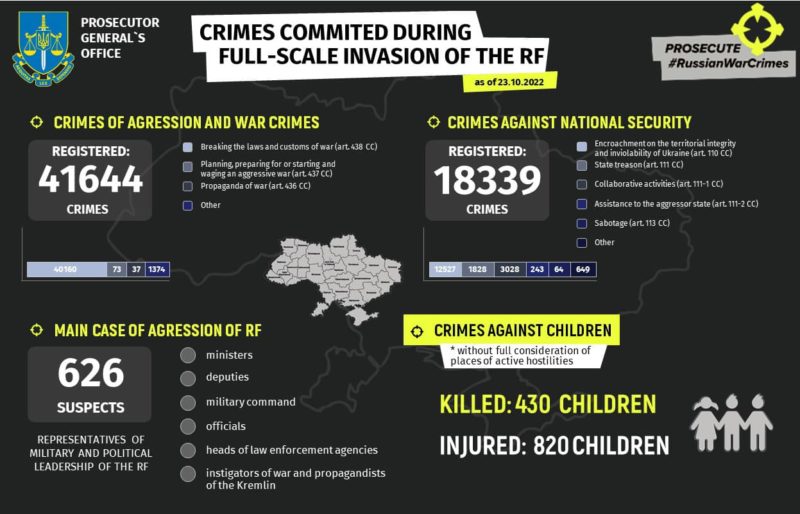 430 children were killed, 820 children injured, 8,709 deported by foe forces, and 243 reported missing – the Office of the Prosecutor General of Ukraine reports as of October 23. 2,663 educational establishments are damaged as a result of shelling and bombings, and 326 of them are destroyed fully. 41,644 crimes of aggression and war crimes and 18,339 crimes against national security were registered.
430 children were killed, 820 children injured, 8,709 deported by foe forces, and 243 reported missing – the Office of the Prosecutor General of Ukraine reports as of October 23. 2,663 educational establishments are damaged as a result of shelling and bombings, and 326 of them are destroyed fully. 41,644 crimes of aggression and war crimes and 18,339 crimes against national security were registered.
Support
Following Russia’s missile strike, Ukraine’s Foreign Minister calls on the West not to delay air defence systems supply to Ukraine, Ukrainska Pravda reports, citing European Pravda. “Saturday in Ukraine starts with a barrage of Russian missiles aimed at critical civilian infrastructure. We have intercepted some of them, others hit targets. Air defence saves lives. There should not be a minute of delay in the capital deciding on air defence systems for Ukraine. Kuleba wrote on Twitter.»
Germany hands over another batch of weapons, ammo, and winter clothing to Ukraine’s Army, Ukrinform reports, citing the federal government press service. “Germany has delivered to Ukraine a new batch of weapons, packages of winter clothing and equipment for the military.
As follows from the updated list of deliveries, five more armoured recovery vehicles were transferred (the same number as delivered in the previous consignment); 7 heavy and medium bridge systems; 167,000 cartridges for firearms, 100 tents (the total number now reaches 200); 183 generators (previously 12 were transferred); 116,000 winter jackets; 80,000 winter pants; and 240,000 winter hats.”
A $1 trillion question for the West: How to rebuild shattered Ukraine, the Editorial Board at The Washington Post asks. “Beyond Ukraine’s stunning recent battlefield successes, eight months of war have rendered the country a physical, financial and economic basket case. Millions of refugees have fled, the country’s gross domestic product has shrunk by about one-third, and the government, its budget depleted by the war, runs monthly deficits of $4 billion or more — mainly financed by Western grants, a lifeline for teachers, retirees living on pensions and millions of others.
Even if Russia were to withdraw now, Ukraine would remain enfeebled for years. Before Russian President Vladimir Putin rained missiles on Ukrainian power plants and other facilities this month, the cost of repairing damage to the country’s critical infrastructure had already been estimated at nearly $200 billion, according to a study by the Kyiv School of Economics. And that is just a fraction of the overall wreckage wrought by Moscow’s indiscriminate attacks.
Rebuilding the country, among Europe’s biggest by population and area, will be a generational undertaking. “It’s not every day that you rebuild a whole country,” said Vlad Rashkovan, a former deputy governor of the Ukrainian central bank who now represents the country on the International Monetary Fund’s executive board. One question — the $1 trillion question, in the estimate of some economists — is who will pay for it. The United States and Europe, along with international banks and development institutions, must take leading and shared roles.
For Ukraine to succeed, it must also be reformed and broadly reinvented as a viable candidate for admission into the European Union, which can wield the leverage to effect those reforms. That means the reconstruction of Ukraine will depend on more than cash and concrete, although heroic quantities of both are needed. Ultimately its fate will turn on a transformation of mind-set and governance in a nation notorious for oligarchs and endemic corruption. Even before the shooting stops, the country must launch a durable, ironclad, transparent project to transform ministries, markets, courts, businesses and institutions, raising them to Western democratic and free-market standards.
Easier said than done, of course. Prewar Ukraine aspired to join the E.U., in the sense that a C student aspires to admission to the Ivy League. Transparency International ranks it as Europe’s third-most-corrupt country, behind only Russia and Azerbaijan. When a top advocate for reform in Ukraine was asked recently how corruption was faring in the country after months of war, he responded dryly: “The good thing is, there’s no money.”
Ukrainian President Volodymyr Zelensky, rightly lionized as an inspirational wartime leader, was ineffective at best during his first three years in office in rolling back graft, the very promise that got him elected in 2019. His second prime minister, dismissed in 2020, said Mr. Zelensky fired him because the government’s own anti-corruption efforts were threatening wealthy power brokers close to the president. Hundreds of millions of dollars in government funds and foreign aid have been siphoned off in recent years by oligarchs, who have used Ukraine’s several thousand state-run companies as ATMs, with the government’s connivance.
Reforms need to start even as rebuilding and humanitarian efforts accelerate in shattered towns and cities from which Russian troops have withdrawn. They are key not only to launch Ukraine on what will be a long path toward E.U. membership — an exceptionally rigorous process — but also to signal to Western governments and multilateral institutions that their aid dollars will not be leached away by oligarchs and kleptocrats.
Ukraine has begun an impressive reconstruction planning effort — thousands of officials and multiple working groups are hammering out blueprints to rebuild housing, roads, transportation hubs, factories, communications towers, and water and sewer systems. Its own full-court press should be matched by an intensified international focus on Ukraine’s long-range needs, even as the West rushes funds, arms and materiel to help fight an existential war against Russia.
Western leaders cannot drag their feet on determining who will oversee and coordinate the hundreds of billions of dollars that will be required over time. Among the plausible candidates are the Group of Seven, the World Bank, the European Bank for Reconstruction and Development and the E.U. itself. Someone needs to be in charge, and soon. A good place to start on that question is Berlin, where an international conference on Ukraine’s reconstruction is set for Tuesday.
At the same time, Ukraine should be on notice that Western aid will be heavily conditioned, and that the tsunami of grants and soft loans that officials in Kyiv hope for is likely to ramp up gradually. That will disappoint some Ukrainians. But it is realistic, given the political and economic pressures in donor countries grappling with energy inflation, nationalism and war fatigue. Pledges for Afghanistan’s reconstruction have so far fallen short of the United Nations’ target amount. The E.U.’s own promise earlier this year of 9 billion euros to close Ukraine’s monthly budget gaps has so far yielded just a fraction of that amount.
Ukrainians understandably want the rebuilding project to tap Russian assets that have been frozen by the West, including $300 billion in Russian Central Bank deposits. No question: Moscow should pay war reparations. But legal, financial and political obstacles stand in the way. Even if some Russian assets can be seized or extracted through negotiations to help Ukraine rebuild, that will likely take years.
Other moves can and should happen faster. The West is already sending large aid packages to address immediate problems beyond the battlefields. In August, the State Department announced an $89 million grant to help disable hundreds of thousands of Russian mines scattered over an area bigger than Virginia and Maryland combined.
Another critical measure is to establish an insurance fund, backed by international financial institutions, to promote private-sector investment. Without that, businesses are unlikely to be able to insure projects they are considering in Ukraine. Corporations typically move faster than international donors; they are key to building wealth in a postwar Ukraine.
It is a vital Western interest not only to defeat a blood-soaked invasion but also to get Ukraine right in the long run. Since the Soviet collapse three decades ago set Ukraine free as an independent country, its anemic institutions, deep-rooted corruption and misgovernance were promoted and exploited by Moscow. The result has been a cataclysm.
The best course now is to rearrange Europe’s security architecture by ensuring that Ukraine is reborn as a vibrant, wholly modern country — a bulwark against an eastern neighbor that might remain brutish for the foreseeable future.”
New Developments
- Zelenskyy announces when negotiations with Russia can resume, Ukrainska Pravda reports. “President Volodymyr Zelenskyy states that Ukraine can open negotiations with Russia after the return of all its territories within the borders of 1991, but there will be no return of relations with Russia that existed before the war.”
- Verkhovna Rada introduced a draft resolution recognising Belarus temporarily occupied country, Ukrainska Pravda reports. A draft resolution recognising Belarus as a temporarily occupied country has been introduced in Verkhovna Rada, Ukraine’s Parliament. The resolution is introduced as “an appeal to the international community to recognise the territory of Belarus as temporarily occupied by Russia; revocation of the international legal recognition of the government of [Aleksandr] Lukashenko; termination of Belarusian participation in international organisations (UN, IMF, etc.); and as an appeal to synchronise sanctions against Russia with those against Belarus as an occupied territory, and removing any opportunities for Russia to circumvent sanctions via Belarus or to use Belarus as an offshore zone.”
- Kuleba calls for Russia to be stripped of its seat in UN Security Council due to war crimes in Ukraine, Ukrinform reports. “Ukraine’s Foreign Minister, Dmytro Kuleba, has called for Russia to be stripped of its permanent seat in the UN Security Council due to numerous war crimes committed by Russian troops in Ukraine during the full-scale aggression against the country.”
- Russian Permanent Representative to UN leaves UN Security Council meeting before Ukrainian Representative’s speech, Ukrainska Pravda reports. “Vasilii Nebenzia, the Permanent Representative of Russia to the United Nations, has announced that he left the UN Security Council meeting in order not to hear a speech by Sergiy Kyslytsya, the Permanent Representative of Ukraine.”
- The US is open to diplomacy to achieve peace in Ukraine, but Russia does not want this – Blinken, Ukrinform reports. “Blinken said the US would consider all means to advance diplomacy, however, Russia does not show any signs of a desire to participate in meaningful diplomacy. Blinken said that when it comes to ending the war through diplomatic efforts, it depends entirely on whether the Russian Federation reaches a point where it is really interested in ending the aggression it has unleashed.”
- Ukraine should decide on when to start talks on ending war – Macron, Ukrinform reports. “French President Emmanuel Macron believes that the return to negotiations should be part of the way to end Russia’s war against Ukraine. Ukraine must determine whether such a moment has come. “We are not fighting in Ukraine. We support Ukraine. We impose sanctions against Russia. But we are not taking part in this war, so it is not in our power to stop it, as we are not a party to this conflict,” the French president said.”
Assessment
- On the war.
The Institute for the Study of War has made the following assessment as of 22 October 2022:
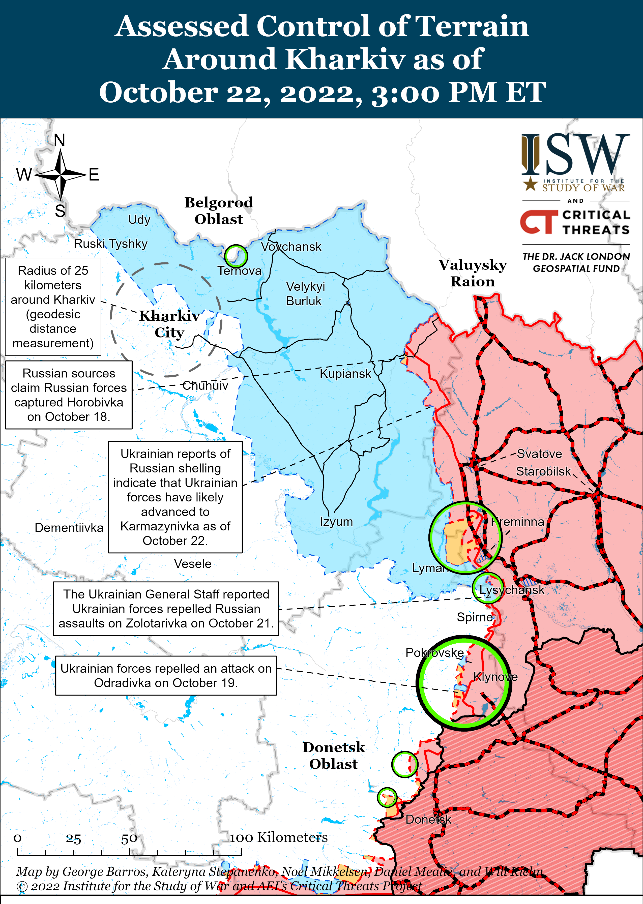 Russian sources claimed that Ukrainian forces conducted counteroffensive operations in the direction of Kreminna and Svatove on October 22. The Russian Ministry of Defense (MoD) claimed that Russian forces repelled a Ukrainian assault in the direction of Kuzymivka (13km northwest of Svatove) near the N26 highway that leads into Svatove from the north. The Russian MoD also claimed that Russian forces repelled Ukrainian attacks northwest of Kreminna near Novovodiane (24km northwest of Kreminna) and Chervonopopivka (6km northwest of Kreminna). A Russian milblogger also claimed that Russian forces repelled a Ukrainian assault west of Kreminna near Terny. A Russian Combat Reserve BARS-13 affiliated Telegram channel claimed that BARS-13 artillery units repelled an attempted Ukrainian advance north of Kreminna. The BARS-13 affiliated Telegram channel also claimed that Ukrainian maneuvers near Terny and Novosadove (17km northwest of Kreminna) suggested that Russian forces lack continuous defensive positions along the R66 Svatove-Kreminna highway, despite previous claims from Russian sources to the contrary. ISW cannot independently verify Russian claims [….].
Russian sources claimed that Ukrainian forces conducted counteroffensive operations in the direction of Kreminna and Svatove on October 22. The Russian Ministry of Defense (MoD) claimed that Russian forces repelled a Ukrainian assault in the direction of Kuzymivka (13km northwest of Svatove) near the N26 highway that leads into Svatove from the north. The Russian MoD also claimed that Russian forces repelled Ukrainian attacks northwest of Kreminna near Novovodiane (24km northwest of Kreminna) and Chervonopopivka (6km northwest of Kreminna). A Russian milblogger also claimed that Russian forces repelled a Ukrainian assault west of Kreminna near Terny. A Russian Combat Reserve BARS-13 affiliated Telegram channel claimed that BARS-13 artillery units repelled an attempted Ukrainian advance north of Kreminna. The BARS-13 affiliated Telegram channel also claimed that Ukrainian maneuvers near Terny and Novosadove (17km northwest of Kreminna) suggested that Russian forces lack continuous defensive positions along the R66 Svatove-Kreminna highway, despite previous claims from Russian sources to the contrary. ISW cannot independently verify Russian claims [….].
Russian forces conducted unsuccessful limited counterattacks to regain lost territory in Kharkiv, Luhansk, and Donetsk Oblasts on October 22. The Ukrainian General Staff reported that Ukrainian forces repelled a Russian ground attack near Ternova (20km southwest of Vovchansk) in Kharkiv Oblast. The Ukrainian General Staff also reported that Ukrainian forces repelled Russian attacks in the vicinity of Bilohorivka (15km west of Sievierodonetsk) and Zolotarivka (14km southwest of Sievierodonetsk) in Luhansk Oblast and in the direction of Lyman in Donetsk Oblast. Ukrainian sources reported that Russian forces continued routine indirect fire along the Oskil River-Kreminna line on October 22.
Southern Ukraine: (Kherson Oblast)
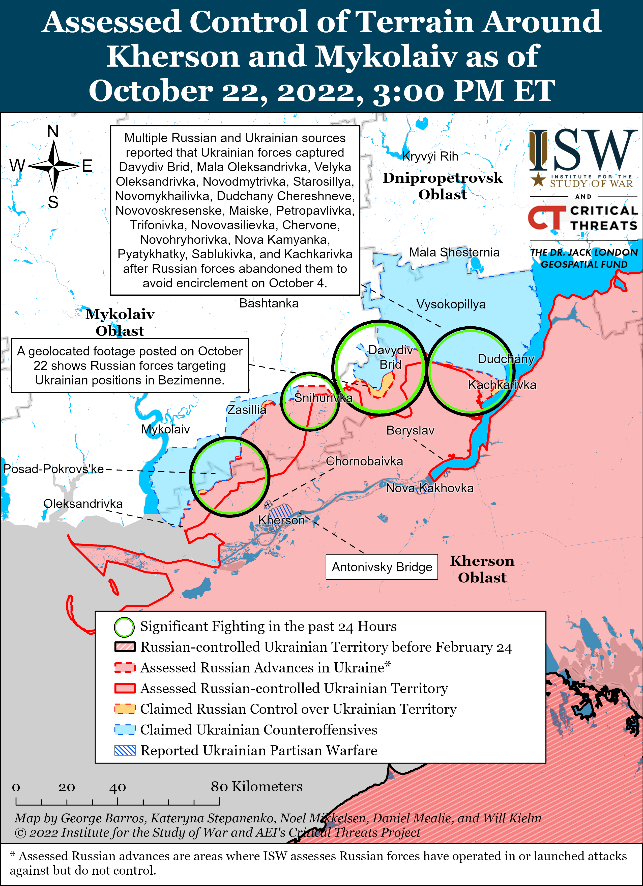 Russian forces continued to withdraw from northwestern Kherson Oblast on October 22. Russian forces are likely conducting a fighting withdrawal and are continuing to strike Ukrainian positions in northwestern Kherson Oblast. The Ukrainian General Staff reported that Russian forces shelled settlements near the Inhulets River and northwest of Kherson City and conducted an airstrike against Novovoskresenske (about 66km northeast of Nova Kakhovka). Ukraine’s Southern Operational Command stated that Russian helicopters attacked Ukrainian forces in Nova Kamianka and Tryfonivka (about 55km northeast of Nova Kakhovka) three times. Ukraine‘s Southern Operational Command added that Russian forces also attacked Novovoskresenske and settlements in its vicinity with Iranian-made Shahed-136 drones and S-300 systems attacking ground targets. The Russian MoD claimed that Russian forces repelled several Ukrainian attacks in northwestern Kherson Oblast. Russian proxy officials claimed that Russian paratroopers (VDV units) are continuing to operate in northern Kherson Oblast. Geolocated footage showed Russian artillery targeting Ukrainian forces in Bezimenne, about 15km southeast of Inhulets River.
Russian forces continued to withdraw from northwestern Kherson Oblast on October 22. Russian forces are likely conducting a fighting withdrawal and are continuing to strike Ukrainian positions in northwestern Kherson Oblast. The Ukrainian General Staff reported that Russian forces shelled settlements near the Inhulets River and northwest of Kherson City and conducted an airstrike against Novovoskresenske (about 66km northeast of Nova Kakhovka). Ukraine’s Southern Operational Command stated that Russian helicopters attacked Ukrainian forces in Nova Kamianka and Tryfonivka (about 55km northeast of Nova Kakhovka) three times. Ukraine‘s Southern Operational Command added that Russian forces also attacked Novovoskresenske and settlements in its vicinity with Iranian-made Shahed-136 drones and S-300 systems attacking ground targets. The Russian MoD claimed that Russian forces repelled several Ukrainian attacks in northwestern Kherson Oblast. Russian proxy officials claimed that Russian paratroopers (VDV units) are continuing to operate in northern Kherson Oblast. Geolocated footage showed Russian artillery targeting Ukrainian forces in Bezimenne, about 15km southeast of Inhulets River.
Ukraine’s air defenses shot down 16 Iranian-made kamikaze drones in Mykolaiv Oblast last night
Ukrainian forces continued to target Russian logistics, military equipment, and positions in central Kherson Oblast. The Ukrainian General Staff confirmed that Ukrainian forces struck a Russian repair base in Nova Kakhovka on October 20, and geolocated footage published on October 22 showed the aftermath of the Ukrainian strike on a Russian surface-to-air missile system in the city. Russian milbloggers claimed that Ukrainian forces shelled the Kakhovka Hydroelectric Power Plant. Ukraine’s Southern Operational Command reported that Ukrainian forces shot down a Russian attack helicopter and destroyed three ammunition depots in the Beryslav Raion.
Russian forces continued to withdraw from western Kherson Oblast while preparing to conduct delaying actions that will likely be only partially effective. The Ukrainian General Staff reported that Russian forces have completely abandoned their positions in Charivne and Chkalove (both approximately 33km northwest of Nova Kakhovka), and Russian officers and medics have reportedly evacuated from Beryslav. The Ukrainian General Staff added that Russian forces are also removing patients from the Kakhovka Hospital on the eastern bank of the Dnipro River, likely to free up hospital beds for Russian military casualties that may result from the withdrawal across the river. The Ukrainian General Staff noted that some Russian elements are preparing Kherson City for urban combat, while other servicemembers continue to flee the city via the ferry operating in the vicinity of the Antonivsky Bridge. The UK Ministry of Defense reported on October 22 that Russian forces completed the construction of a barge bridge alongside the damaged bridge and forecasted that the barge bridge would become a critical crossing point for Russian forces as Ukrainian forces advance toward Kherson City. A large part of the Kherson City population has also reportedly left the city.
Russian forces are preparing a series of delaying actions with mixed efficacy. Russian forces are likely preparing to destroy the dam at the Kakhovka Hydroelectric Power Plant (KHPP), flooding and widening the Dnipro River to delay any Ukrainian advances. Russian occupation authorities in Nova Kakhovka are likely attempting to moderate the resultant flooding; Nova Kakhovka Occupation head Vladimir Leontyev said on October 22 that Russian authorities are lowering the volume of water from the reservoir behind the dam to minimize damage in case the KHPP is destroyed but stayed true to the false narrative that Ukraine, not Russia, would blow the dam. Ukraine has no interest destroying the dam and every interest in preserving the energy supply in newly-liberated parts of Kherson Oblast. Ukraine’s Southern Operational Command reiterated that Russian military leadership has moved their officer corps across the river but left newly-mobilized men on the western bank of the Dnipro River as a detachment left in contact. Using such inexperienced forces to conduct a delaying action could prompt a Russian rout if Ukrainian forces choose to press the attack, as ISW previously assessed. One Russian milblogger noted that the situation in Kherson Oblast is dire for Russian troops, noting that it is ”virtually impossible” for Russia to evacuate troops from the first lines of defense and that only two questions remain: how to withdraw the final front line of forces, and how to explain the withdrawal to the Russian population.
Russian occupation authorities ordered the forcible “evacuation” of civilians from Kherson City on October 22. […] The occupation administration encouraged evacuees to bring clothes, valuables, and documents, indicating that they do not expect a rapid Russian or civilian return to western Kherson. Russian forces expect to leave the city and are therefore likely trying to depopulate parts of the oblast that Ukraine will recapture, damaging the long-term social and economic viability of southern Ukraine. Russian authorities are likely also making initial efforts to evacuate at least those civilians who are willing to cooperate with Russian occupation authorities and would otherwise be in the path of flooding resulting from the blown Kakhovka dam. […]
Ongoing Russian strikes on Ukrainian civilian infrastructure are extraordinarily unlikely to erode the Ukrainian will to fight but will increasingly pose an economic and humanitarian challenge for Ukraine as temperatures drop. Russian shelling and strikes have damaged approximately 30% of Ukraine’s energy infrastructure in recent weeks, prompting rolling blackouts across the country, not just along the front lines. Blackouts combined with cold winter weather and damaged civilian buildings will likely increase the suffering of Ukraine’s civilian population this winter. Russia’s campaign of targeting Ukrainian energy infrastructure is creating a humanitarian tragedy without meaningfully altering the battlefield situation, and Russian excuses for such strikes are wearing increasingly thin. The Russian Permanent Representative to the United Nations, Vasily Nevenzya, claimed on October 22 that Russian drones are only hitting civilian targets in Ukraine because Ukrainian defensive fire requires the drones to change course, a bizarre admission of culpability.
Wagner Group financier Yevgeny Prigozhin continues to create rifts within the Russian government by publicizing the so-called “Wagner line” of fortifications in northeastern Ukraine, which appears misaligned with Kremlin-led narratives on the course of the war. Prigozhin and Wagner-affiliated Telegram channels announced that Russian regional officials paused the extension of the Wagner Line fortifications that run behind the line of contact in Luhansk and Donetsk Oblasts and into Russia’s Belgorod Oblast. Prigozhin accused the Russian bureaucracy—which he characterized as ”bureaucrat-enemies”—of ”directly opposing the interests of the population” and not protecting the Russian population by supporting the construction of the line. The Russian nationalist community has repeatedly accused the Kremlin of failing to defend the Belgorod Oblast border, and Prigozhin may be attempting to amplify their demands. The Kremlin is likely attempting to maintain its limited framing of the war, which will likely continue to upset the nationalist community that is seemingly concerned by the lack of defenses around Belgorod Oblast. Prigozhin and Wagner-affiliated Telegram channels previously indicated that there is an ongoing schism within the Kremlin’s power circles between officials that are hesitant to continue the war due to personal interest and those in favor of Russian total victory.
Russian maps show that Prigozhin’s proposed Wagner Line extension would defend the border between Belgorod Oblast and Ukraine’s Sumy, Kharkiv, and Luhansk oblasts, but notably would not cover northern Luhansk Oblast up to the line of contact, placing it at odds with Kremlin promises to defend all of Luhansk. Other maps show that the Luhansk-Donetsk Wagner Line segment will largely only defend the territory of Luhansk Oblast that Russian proxy forces controlled prior to their February 24 full-scale invasion. The line covers some newly occupied settlements like Lysychansk, Zolote, and Popasna, but excludes Kreminna and Sievierodonetsk. Prigozhin and Wagner commanders are likely preparing to defend the positions they think they can realistically hold, not the present extent of Russian lines or all of the territory the Kremlin claims to have annexed, and are likely not confident in Russia’s ability to defend settlements north of Lysychansk such as Kreminna and Svatove.
Key Takeaways
- Russian forces continued large-scale strikes on Ukrainian infrastructure. Ongoing strikes are unlikely to erode Ukrainian will to fight but will pose economic and humanitarian challenges throughout the winter.
- Russian forces continued to withdraw from western Kherson Oblast while preparing for delaying actions that will likely be only partially effective.
- Occupation authorities in Kherson Oblast ordered civilians to evacuate east on October 21. Evacuations from Kherson City will support likely Russian plans to blow up the Kakhovka Hydroelectric Plant (HPP) dam to cover their withdrawal.
- Prigozhin-led efforts to build a “Wagner Line” of defensive fortifications extend through central Luhansk Oblast and in limited capacity into Belgorod.
- Prigozhin’s efforts and messaging, including the creation of the “Wagner Line,” are increasingly out of line with Kremlin rhetoric and are critical of what Prigozhin claims are slow-moving “bureaucrat-enemies.” Such activism endears Prigozhin to Russian nationalists, who are dissatisfied with limited Kremlin escalation and MoD disorganization.
- Russian sources reported Ukrainian counteroffensives in the direction of Kreminna and Svatove on October 22.
- Russian forces conducted limited counterattacks with no confirmed advances to regain lost territory in Kharkiv, Luhansk, and Donetsk oblasts on October 22.
- Crimean occupation authorities banned filming of infrastructure and military logistics likely due to continued Ukrainian strikes targeting Russian supply hubs and lines.
- ISW identified additional reports on October 22 that Russian mobilization has not met force generation goals and will likely continue in alternative forms.
- Russian and occupation administration officials continued to forcibly relocate residents in Russian-occupied territories of Ukraine as of October 22.
- Russian and occupation officials continued to restrict the movement of residents living in Russian-occupied territories of Ukraine and increase the checkpoint controls as of October 22.“
Russian Troops in Belarus Spur Debate Over the Threat to Ukraine, The New York Times reports. “The United States and its allies are playing down the dangers posed by the deployment of thousands of Russian soldiers to Belarus, but the intelligence assessments come with a dose of uncertainty. Russia is massing thousands of troops in its western neighbor Belarus, raising fears that Moscow might plan to open a new front in its war against Ukraine, but officials from Kyiv to Washington are casting doubt on whether the military buildup represents a serious threat.
With Russia already struggling to defend territory in eastern and southern Ukraine, it can ill afford to pick a new fight on a third front in the north on the border with Belarus, officials and analysts say. We have to be cautious, but I doubt that Russians are at this moment capable of opening another front line against Ukraine, at least not a successful front, Latvia’s defense minister, Artis Pabriks, said on Friday. He said some 10,000 of the Kremlin’s forces were gathering in Belarus, possibly to try to disrupt the flow of Western weapons into Ukraine from Poland. […]
Britain’s Defense Ministry said in an intelligence assessment on Friday that the flurry of military activity in Belarus is “likely an attempt to demonstrate Russian-BelaRussian solidarity and to convince Ukraine to divert forces to guard the northern border.” Some Western officials say the Russian move is probably just a feint or a training mission, while others say it could be preparation for an attack, though likely not a very effective one, but their views come with a heavy dose of uncertainty.
Those who think a new offensive is possible say it probably would be aimed not at Kyiv, Ukraine’s capital — which the Russians failed to capture with a thrust out of Belarus at the outset of the invasion — but far to the west, near the border with Poland, to disrupt Western shipments of arms and other supplies. But plunging into western Ukraine near the Polish border would be very, very risky for both Aleksandr G. Lukashenko, the strongman leader of Belarus, and for the Kremlin because the region is the traditional heartland of Ukrainian nationalism, said Valery Kavaleuski, a former Belarusian diplomat and now a foreign affairs adviser to his country’s exiled opposition movement. It would be suicidal, a very bad idea but who knows what they might do, he added. […]
Mr. Lukashenko, Belarus’s increasingly Moscow-dependent president, announced last week that his country and Russia were forming a new joint military force, with 70,000 Belarusian troops and up to 15,000 Russians, putatively to guard against NATO. A Ukrainian general, Oleksiy Gromov, said on Thursday that the threat of a possible invasion from Belarus was growing. But Ukraine’s military intelligence agency does not see an immediate danger, a spokesman, Vadym Skibitsky, said in an interview on Friday.
Several thousand newly mobilized Russian soldiers are deployed in Belarus at training sites, Mr. Skibitsky said, but they are not accompanied by the tanks, artillery or fuel trucks and other logistical support they would need to invade and face Ukraine’s battle-hardened troops. We see these elements now moving into Belarus, but we do not see the movement of equipment, he said.
Mr. Putin used the territory of Belarus, his closest military and political ally, as a staging ground for his February invasion and his forces have since launched missiles and drones into Ukraine from there. But Mr. Lukashenko has resisted Russian pressure to get more involved in the war.
But Michael R. Carpenter, the United States ambassador to the Organization for Security and Cooperation in Europe in Vienna, cautioned in a telephone interview that Russia and Belarus had both shrouded the purpose of their new joint force in an opaque fog that makes it “hard to say whether there is some sort of operation being prepared from Belarus or this is just an attempt to pin down Ukrainian troops.” […]
Air Force Brig. Gen. Patrick S. Ryder, a Pentagon spokesman, also played down the likelihood of a Russian invasion from Belarus: “We don’t currently have any indications of a potential imminent military action on that front,” he told a briefing Thursday. Many Western and Ukrainian officials believe that Belarus’s primary role will be to help Russia train new draftees, many of whom have no military experience, before sending them to Ukraine. Russia’s own training facilities have been stretched to the breaking point since Mr. Putin last month ordered the conscription of as many as 300,000 troops to prop up his faltering war effort. Some draftees have been dispatched to the front lines with minimal preparation; some have already been killed.
Mr. Lukashenko has held power for 28 years thanks to support from Moscow, while fending off a yearslong push by Mr. Putin to, in effect, merge their countries, ending Belarus’s independence. Mr. Pabriks, the Latvian defense minister, said Mr. Lukashenko was “moving things to the left, moving things to the right, pretending that he is doing stuff but obviously the Russian tide is against him. Lukashenko is trying to maneuver in an increasingly narrow space. Obviously Putin is trying to bring Belarus more into his war against Ukraine, but Lukashenko understands that would be the end of his time if he did this, Mr. Pabriks said.
Mr. Lukashenko, he added, had become so dependent on Russia for his own political survival that Russia controls his country and we should assume probably that there will be more involvement from the Belarusian side against the Ukrainians, but I very much doubt that this would bring large benefits to Russia. […] On Friday, Ukraine’s armed forces said in a statement that if the country were attacked it would “respond as fiercely as we respond to all occupiers.” It also said that, in the event that troops from Belarus were ordered to attack, they should disobey their leaders and surrender.”
[/box]
Iranian instructors help Russians launch Shahed-136 drone attacks from Belarus
- Consequences and what to do?
Thousands protest in Germany demanding solidarity in energy relief, Reuters reports. “Tens of thousands of protesters in six German cities gathered on Saturday to demand a more just distribution of government funds to deal with rising energy prices and living costs and a faster transition away from fossil fuels. Protesters marched in Berlin, Duesseldorf, Hannover, Stuttgart, Dresden and Frankfurt-am-Main, holding signs bearing slogans on everything from lowering inflation to switching off nuclear power and more energy price subsidies for the poor.
Germany’s parliament on Friday approved the government’s 200 billion euro ($195 billion) rescue package which aims to protect companies and households from the impact of soaring energy prices. The package includes a one-off payment to cover one monthly gas bill for households and small and medium-sized businesses and a mechanism to limit prices from March.
It will also finance a cap electricity prices for households and industry retroactively from March for spot prices and from December for future prices, with additional funding drawn from electricity companies’ profits. German inflation in September hit its highest level in more than a quarter of a century at 10.9%, driven up by higher energy costs.”
Hans Petter Midttun’s assessment
Today’s assessment will be published as a separate article. A teaser:
“Despite the huge flaws uncovered and recent Ukrainian triumphs, it is important not to underestimate Russia’s ability to reconstitute its military potential. Especially considering both Ukrainian and Western challenges. As Russian defeat cannot be taken for granted we must respond to Russian resolve: We must dig in and increase our joint efforts.
In 2023 Russia will be waging war with an increasingly depleted, demotivated and unqualified Armed Forces.
Its retreat from the Western Kherson and the upcoming winter might, however, give it time to prepare for the next phase of the war. Dnipro will temporarily stop further Ukrainian advances in the south. The winter will not only reduce the efficiency of UAVs’ recognisance and satellite-based intelligence means but also turn the ground into mud making further ground assaults increasingly difficult. The winter is expected to be milder than normal, possibly denying Ukraine the opportunity to manoeuvre quickly over frozen ground.
It will give Russia time to train the newly mobilised forces, having possibly mobilised more than one million soldiers. While the fundamental flaws will remain, it will explore its core “advantage”: its fundamental disregard for human life.”




